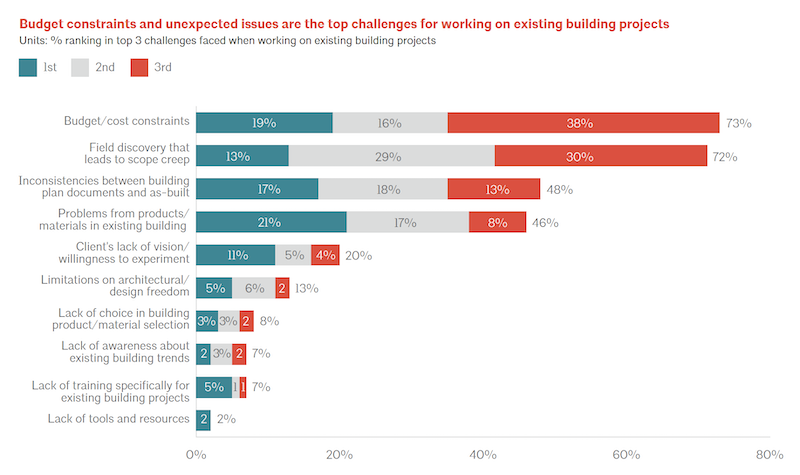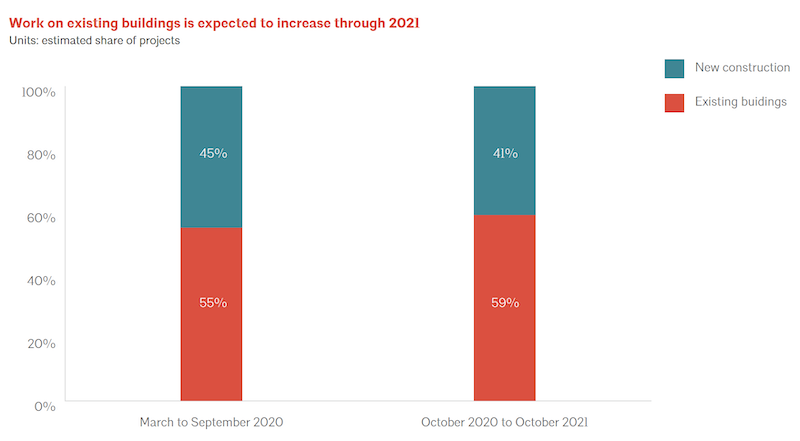The coronavirus pandemic accelerated a shift toward architectural design work on existing buildings that already had been underway. That shift presents new opportunities, but also challenges that manufacturers and other partners can help architects meet. But when it comes to designing sustainably, architects need to become more than just “passive advisors” who leave final decisions to clients.
These are some of the key findings from a new 43-page report, “Business Opportunities & Sustainability Trends Amidst a Pandemic,” that has been published by the American Institute of Architects (AIA) in partnership with Oldcastle Building Technology. The report is based on responses from 229 architecture firms that completed a survey that was in the field from October 20 through November 17, 2020.

The largest number of respondents was affected by the recession only moderately.
The study found 2020 to be “a tale of two markets,” with declining demand in most nonresidential sectors and increasing demand in residential sectors, especially single family. From March to September 2020, surveyed respondents reported an increase of 34% for single-family work and 12% for multifamily; and a net decrease in work in the nonresidential sectors including retail (down 49%), offices (-35%) and Higher Ed (-29%).

Demand for residential design was the one silver lining of last year's COVID-19 outbreak. And the nonres sectors that took it on the chin are likely to see most of their new work in existing buildings in 2021.

According to the AIA Consensus Construction Forecast released in January 2021, nonresidential building spending is expected to continue to decrease with a forecasted decline of 5.7% in 2021. Out of nonresidential building spending, the commercial sector is expected to continue to decline the most in 2021, by 7.1%, compared with 4% for the institutional sector.
Healthcare, higher education, and K–12 education are expected to have the greatest opportunities for growth in existing buildings in 2021, whereas there are declines expected in new building projects.
EXTERNAL COMMUNICATION WAS TOUGH DURING PANDEMIC

The pandemic's impact on client relationships was relatively minor. But budgeting was cited as the biggest challenge for architects working on existing buildings.

The two biggest challenges architectural professionals reported facing with existing buildings were budget/cost constraints (73% of responses) and field discovery that leads to scope creep (72%). Further, nearly half (48%) of those surveyed reported the challenges of inconsistencies between building plan documents and as-built, and problems from products/materials in existing buildings (46%).
Many firms shifted into a virtual work environment during the pandemic, and found it difficult to maintain productivity. Of the 71% of architects who reported negative impacts on construction, some of the reasons given were delayed timelines, price increases for materials or limited materials, lack of workers, COVID-19 restrictions, and difficulties with external communications.
A little over one quarter (26%) reported the pandemic negatively impacted their relationships with clients. The primary reason for that was also communication (reported by 63%, the top reason) but closely followed by more worsened collaboration. Difficult communications were also cited as the main reason for any negative impact on supplier relationships.
On the positive side, design quality was the only business aspect that showed no notable impact from the pandemic—with a vast majority (77%) reporting no impact. Other respondents were encouraged by technology, focus on design, and less distraction.
SUSTAINABILITY DEMAND CONTINUES TO EXPAND

Not surprisingly, Higher Ed is deemed by architects as being the nonres sector where sustainability innovation flourishes. The study found, though, that a sizable number of architects are still on the sidelines when it comes to moving clients toward sustainable project goals.

Architects were hopeful about their opportunities from sustainable design, especially in housing and healthcare projects. The majority of those surveyed reported that clients increasingly are willing to invest in design that leads to better occupant health and productivity (78%) and are willing to pay for design and materials that reduce disease transmission (61%). Additionally, 63% of respondents reported that sustainability concerns increasingly are important when specifying building products/materials and that they are seeing consultants increasingly focused on sustainability.
Across nearly all these measures, significantly higher shares of respondents from the largest firms (500 or more employees, which comprise a substantial share of architectural billings) reported client interest in sustainability.
By way of example, the report quotes a commercial owner in the Southeast who says that sustainability and wellness are “core principles for the group, and climate change is a fundamental consideration. Looking forward, our future projects will have similar sensitivity to the impacts of climate change.”
Even after the pandemic is controlled, data and history suggest that this concern will remain strong, given both owners’ desire to mitigate future risk and the historical strength of improved health outcomes as a driver to green building and sustainable design. Sixty-three percent of respondents also said sustainability is increasingly important in specification of building products and materials.
ARCHITECTS MUST LEAD THE CHARGE TOWARD SUSTAINBILITY

Construction, planning and project management were impacted by the pandemic's restrictions on physical presences on jobsites.
The study revealed a net positive impact of the pandemic on innovation and finding sustainable solutions, with 34% of respondents reporting that the pandemic helped make it less difficult to innovate and 25% noting that it made it less difficult to find new sustainable solutions.
While architects are strong advocates of sustainability, the report states that there room for architects to take on more leadership roles as designers, educators, partners, and specifiers. When it comes to their role educating clients about sustainability, more than a quarter (27%) are on the forefront—integrating health and sustainability considerations into all projects. But nearly half (48%) act in more of an advisory capacity, with that split between those who serve as the decision-maker (16%) and those who defer decisions to clients (32%). And there is still a quarter who are either hands-off, offering options but not prioritizing sustainability, or reactionary.
The report’s findings are consistent with architects’ general approach to new product and material use. While there are a very small percentage of innovators and laggards, most fall into the middle, with 28% of respondents identifying as early adopters and 23% identifying as being in the “early majority,” or using new products after some use.
Related Stories
Multifamily Housing | Apr 12, 2024
Habitat starts leasing Cassidy on Canal, a new luxury rental high-rise in Chicago
New 33-story Class A rental tower, designed by SCB, will offer 343 rental units.
Student Housing | Apr 12, 2024
Construction begins on Auburn University’s new first-year residence hall
The new first-year residence hall along Auburn University's Haley Concourse.
K-12 Schools | Apr 11, 2024
Eric Dinges named CEO of PBK
Eric Dinges named CEO of PBK Architects, Houston.
Construction Costs | Apr 11, 2024
Construction materials prices increase 0.4% in March 2024
Construction input prices increased 0.4% in March compared to the previous month, according to an Associated Builders and Contractors analysis of the U.S. Bureau of Labor Statistics’ Producer Price Index data released today. Nonresidential construction input prices also increased 0.4% for the month.
Healthcare Facilities | Apr 11, 2024
The just cause in behavioral health design: Make it right
NAC Architecture shares strategies for approaching behavioral health design collaboratively and thoughtfully, rather than simply applying a set of blanket rules.
K-12 Schools | Apr 10, 2024
A San Antonio school will provide early childhood education to a traditionally under-resourced region
In San Antonio, Pre-K 4 SA, which provides preschool for 3- and 4-year-olds, and HOLT Group, which owns industrial and other companies, recently broke ground on an early childhood education: the South Education Center.
University Buildings | Apr 10, 2024
Columbia University to begin construction on New York City’s first all-electric academic research building
Columbia University will soon begin construction on New York City’s first all-electric academic research building. Designed by Kohn Pedersen Fox (KPF), the 80,700-sf building for the university’s Vagelos College of Physicians and Surgeons will provide eight floors of biomedical research and lab facilities as well as symposium and community engagement spaces.
K-12 Schools | Apr 10, 2024
Surprise, surprise: Students excel in modernized K-12 school buildings
Too many of the nation’s school districts are having to make it work with less-than-ideal educational facilities. But at what cost to student performance and staff satisfaction?
Industrial Facilities | Apr 9, 2024
Confessions of a cold storage architect
Designing energy-efficient cold storage facilities that keep food safe and look beautiful takes special knowledge.
Cultural Facilities | Apr 8, 2024
Multipurpose sports facility will be first completed building at Obama Presidential Center
When it opens in late 2025, the Home Court will be the first completed space on the Obama Presidential Center campus in Chicago. Located on the southwest corner of the 19.3-acre Obama Presidential Center in Jackson Park, the Home Court will be the largest gathering space on the campus. Renderings recently have been released of the 45,000-sf multipurpose sports facility and events space designed by Moody Nolan.

















